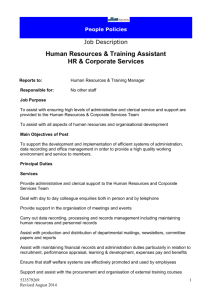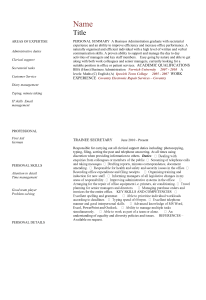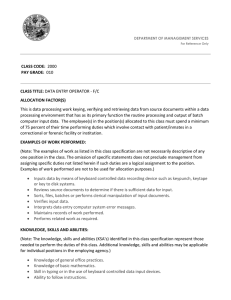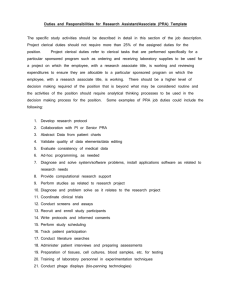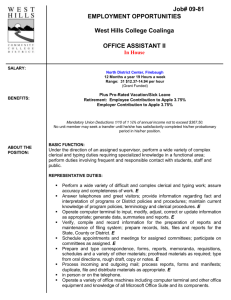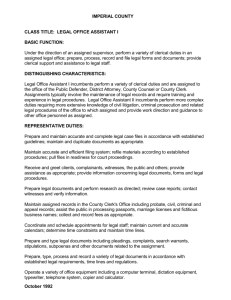Minimum Qualifications
advertisement
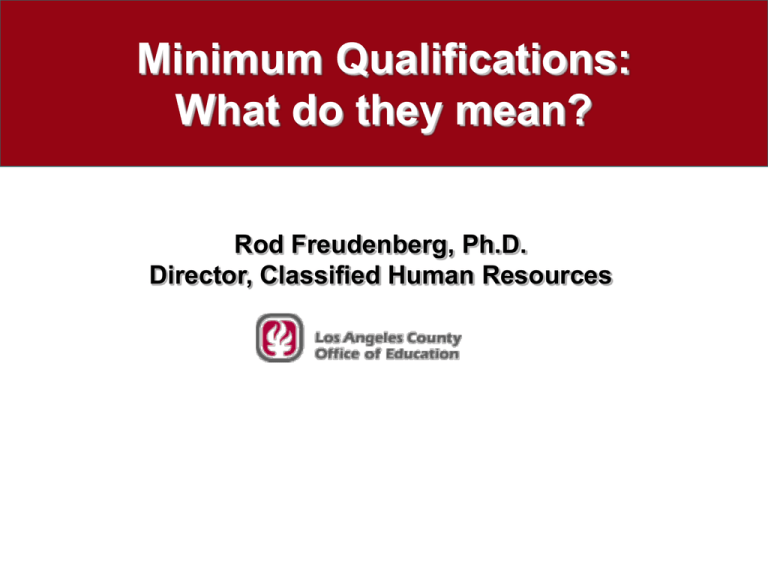
Minimum Qualifications: What do they mean? Rod Freudenberg, Ph.D. Director, Classified Human Resources What we’ll discuss… 2 What is a minimum qualification? What purposes do they serve? What standards do they need to meet? Working with SMEs – What do we bring to the discussion? What does “Education” represent? What does “Experience” represent? Experience “Terms of Art” Substitution Other considerations Special Requirements. What are they? AKA: Minimum Requirements, Entry Qualifications, Pre Reqs, Basic Reqs. Etc. Can be anything: • • • • • • • • • • 3 Education Experience License, certification, membership Completion of training/internship Skill (typing speed) Language Age Physical Ability (e.g., lifting) Perceptual Ability (vision, hearing, etc.) Physical characteristics (e.g., height, weight) Universal in employment, education, certification, memberships, sports etc. What purpose do they serve? Proxy for desired minimal competencies Reading, Writing, Math, Critical Thinking Technical Knowledge Opportunity to acquire and demonstrate necessary proficiencies State an expected career path Rights of passage – pay your dues Lower level work precedes higher level work Enable candidates to self-select out or decide whether the job is right for them Selection Efficiency 4 Eliminate candidates who have a low likelihood of being able to perform the role or tasks. (reduces hiring mistakes) Eliminate candidates who lack the “foundation” or “readiness” to perform or learn to perform the role or tasks. (save training time) Eliminate candidates who can not be physically accommodated for the physical environment, conditions, or equipment of the job. The “Bill Gates Case” of Minimum Quals Basic Qualifications for Microsoft Software Build Engineer Could Bill have gotten a job at Microsoft 25 years ago? (Bill dropped out of Harvard and had no paid experience when he founded Microsoft) Is this the case for no “minimums”? 5 BA/BS degree in Computer Science 4 years in the software development field Base “minimum” on the exception or outlier? Are there “true” minimums? No, any combination is possible, but there are practical minimums. 6 True Positives False Positives False Negatives True Negatives Some general points There is no exact “minimum” Tilting the balance between false negatives and false positives is driven by: Candidate scarcity/abundance • What the “market will bear” • Labor market norms (survey employers) Criticality of the job • Risk of false positives Potential adverse impact on underrepresented groups • Risk of false negatives 7 Reliability and Validity MQs are first part of the selection process MQ are considered a “test” under UGESP Validity and Reliability are necessary considerations Validity pertains to: Reliability pertains to: 8 Job relatedness Differentiates the better from lesser qualified Consistency in interpretation Consistency in application across candidates and across evaluators Predictive Validity Standing (meta analyses) (Schmidt & Hunter, Psychological Bulletin, Vol. 124; Journal of Applied Psychology, Vol. 86) ASSESSMENT TYPE: Work Sample Test/Technical Simulations .54 General Mental Ability Test .51 Structured Employment Interview .51 Accomplishment/Behavioral Consistency Questionnaire .45 Personality/Integrity Test .41 Unstructured Employment Interview .38 Assessment Center/Behavioral Simulations .37 Biodata Measures – empirically keyed .35 Situational Judgment Test .34 References/Secondary Source Ratings .26 T&E – Point Method (years experience, schooling, etc.) 9 Validity Coef. .11 First Major Legal Challenge to MQs Griggs vs. Duke Power • Prior to 1964 CRA, history of Black segregation in Labor Dept (dept having lowest skill, lowest pay) • Post CRA, required HS Diploma (or mental ability testing) for hiring and promotion into other jobs • Adverse Impact established for requirement (proportionately fewer Blacks meeting the requirement) • US Supreme Court in 1971 ruled that businesses must demonstrate requirements are "reasonably related" to the job when adverse impact is established. • Subsequent cases focused on “testing” rather than minimum requirements… (Why?) 10 Recent Legal Development Tucker Vs. Grossmont (Merit System Case) • Manager (Tucker) was laid off, was met the MQs for a lower position never held, position was filled by an outside candidate from an eligibility list • California State Supreme Court ruled that a laid off employee has preferential rights to a lower level vacant position over an outside candidate provided that the employee meets the qualifications for the vacancy. • Court did not state what “qualified” means 11 Attorneys have advised reviewing, clarifying, and explicating minimum qualifications SIOP Principles (4th Edition) (Don’t deal with MQs directly but…) “Professional judgment is necessary in setting any cutoff score and typically is based on a rationale that may include such factors as estimated cost benefit ratio, number of vacancies and selection ratio, expectancy of success versus failure, the consequences of failure on the job, performance and diversity goals of the organization, or judgments as to the knowledge, skill, ability, or other characteristics required by the work.” “When cutoff scores are used as a basis for rejecting applicants, the researcher should document their rationale or justification.” 12 The Law: Education Code 45276 In approving minimum educational and work experience requirements for classified positions, the commission shall insure that such requirements reasonably relate to the duties of the position, as established by the governing board, and that they will admit an adequate field of competition. No requirement may be approved which unduly or unreasonably restricts the field of competition. 13 We have to be “reasonable” or have a “rationale” (SIOP) So how do we do this? But how does the discussion go? Analyst: “What should be the minimum education and experience?” SME: “Oh, I don’t know… How about a bachelors and four years of experience?” Analyst: “Bachelors in what?” SME: “Something related to computers.” Analyst: “Any particular kind of experience?” SME: “In the software development field.” 14 The Mind of the Subject Matter Expert Not necessarily thinking “minimum”… 15 Probably hasn’t given this much thought before you asked Use MQs to raise the performance standard (“Performance sucks, we need to increase the minimum.”) Self-referential (minimum is what I had) Other-referential (what my best employee has) Norm-driven (most who work here have a bachelor’s degree) Image-drive (all who work here should have a Master’s degree) How about “pooling” opinions of multiple SMEs? “You can’t take the average of ignorance and get the truth.” - Unknown source 16 What can we bring to the discussion? 17 1. An interpretive framework 2. Questions 3. “Feel” for what is appropriate Utility of a “Framework” Provide common terminology to increase consistency across analysts and within analysts over ocassions. MQs as part of the organizational “system” for of the classification structure • MQ consciously define and explicate promotional paths • MQ can help differentiate classes by level and type • Supports compensation in point factor approaches 18 Disclaimer This is the current LACOE framework • An example • No “officially recognized” or “generally accepted professional principles or practices” here! • None really exist But we need to open this discussion if we are going to be “reasonable.” So let’s talk… 19 EDUCATION 20 What is Education? Provided by recognized educational institutions A formal, predetermined progression of the acquisition of general and specialized knowledge, skills, and abilities (curriculum) Provides evidence of the acquisition of an organized structure of knowledge with relatively few gaps (standards) Concentrations in specific subject areas provide a broad foundation for assimilating related content that may change, expand, or evolve over time. - “lifelong learning” 21 Why Require Minimum Education? Proxy for transferable skills: • • • • Reading, writing, math Cognitive discipline Broad and structured knowledge Foundation for assimilating new knowledge Experience alone maybe highly relevant but… • May be narrow in content and skills • Contextual, procedural, and systems-specific 22 Kinds of Education: General & Specific 1. General Education Functionally Literate • • • Literate • • • Versatile skills, algebra and beyond Complex, abstract, varied subject matter – multi-domain Reports, analyses, representational material Specific Subject Matter Expertise 23 Adaptive skills, pre-algebraic math Varied and changing content – open domain General office/procedural material and correspondence Super-Literate • • • 2. Elementary skills, basic arithmetic Stable and consistent subject matter – closed domain Instructions, forms, labels, signs, diagrams etc. Specialized course-work – upper division college Education Benchmarks None Required • Functional literacy requirements (literacy testing) • Stable and consistent instructions, forms, labels, signs, diagrams etc. • Interpretive support/redundancy is available High School Diploma • Face valid sign of basic literacy and numeracy skills • Foundation for on-the-job learning changing job content • NCLB requirement for instructional assistants 24 Education Benchmarks (cont’d) Two years of college • Core courses in reading, writing, and math skills (super-literacy) • Subject matter may not be relevant (no major) • Reference in “units” (60 semester or 90 quarter) Associate’s degree or specific courses • Technical or business area • Certifies entry-level preparation for an occupation • A substitution of a given number of college credits in specific subject matter may be used as an “equivalency” (e.g., 15 semester credits in …) 25 Education Benchmarks (cont’d) Three or more years of college with upper division course work • Bachelor’s degree may not be the labor market norm • College-level subject matter knowledge is required • Broad foundation is needed to keep pace with changing job content Bachelor’s degree • Entry-level readiness for a professional/managerial career track • Societally recognized right-of-passage to knowledgebased jobs of high responsibility and consequence • Industry and labor market norm 26 Education Benchmarks (cont’d) Graduate-level course work • Specialized work requiring advanced technical knowledge not provided through experience • The foundation for keeping pace with technical developments in a professional field • The required courses should be specified in type and number. • Reflects admission into a graduate program - evidence of strong academic foundation, academic discipline, and a commitment to an occupational area. Master’s degree (MA, MS, MBA, MPA, etc.) • Same as above, but is the occupational norm. 27 Education Benchmarks (cont’d) Professional degree License, Certificate, or other Regulatory Credential 28 M.D., PH.D., J.D., BSN, etc. Associated with specific occupations May require state licensure or certification Medicine, nursing, and legal professions; trades, contracting, and building inspection; civil engineering, public safety and law enforcement, teaching, etc. Sign Language Interpreter 4.0 RID testing standard MIXING THE MESSAGE: Tag-a-long Phrases “Or a closely related field” “Related” to what? How “close” is close enough? • Problems with consistency in application across candidates and across occasions • SMEs will need to assist in application screen • Circumscribe with reference to the duties of the class • “Bachelor’s degree in management, business administration, public administration, or a field of study closely related to the duties and the knowledge requirements of this classification.” “Preferred” or “Desired” • Nod to SMEs. Value-added but not necessary? A differentiator of better from lesser qualified? • “Preferred over…” “Desired in addition to…” • If preferred or desired, how will it be incorporated into the selection process? 29 “Exchange Rates”: Training for Education 1. 2. College course work vs. Trade School Certificates of Completion Formal Education vs. Completion of training courses and workshops What is the comparability of time and work investment? What is the level of rigor required? • • 30 Does completion represent exposure or mastery? Is it possible to not pass? Education in a Promotional Series Series: Clerical, Analytic, Administrative/Mgmt Set entry education level for the entire promotional series to avoid: A structural barrier (higher education) to advancement “Dead end” positions resulting for employees not possessing the higher requirement, Internal promotional pool may be constricted Increased necessity for “open” recruitments for higher positions in the series 31 EXPERIENCE 32 What Does Experience Represent? An individual’s unique developmental acquisition of general and specialized knowledge, enabling competencies and organizational behavior Experience reflects the opportunity for a person to apply knowledge, learn setting-specific policies, procedures, regulations, and to develop personal work habits and work style. Experience does not assure any of the above, but without experience, development of workrelated competencies cannot be assumed. 33 Dimensions General vs. Specific How much? What kind? What level? In a Promotional Path Internal vs. External Paid vs. Unpaid 34 Kinds of Experience General • Indicative of the development of general, transferable work competencies such as dependability, attention to detail, interpersonal skills, and other kinds of adaptive organizational behavior. • An entry-level job may require only general experience at a particular “level” (to be discussed later) Specific • Indicative of the development and application of professional/technical expertise. • Advanced or promotional-level job would require a track record of application of knowledge and opportunity to have accomplished a significant body of work. 35 How Much Experience? 36 1. What must be mastered by the end of an initial probationary period? What then must be the starting point? 2. What is the duration at which learning diminishes and experience increasingly becomes repetition? Function of… 37 Procedural complexity. Work involving complex procedures will take longer to master and more experience would be required. Job-specific skill proficiency learning curve. Work involving the acquisition of complex knowledge and skills will take longer to master and more experience would be required. Time-to-proficiency should be estimated by subject matter experts. Function of… 38 Task cycle time. Tasks having short cycle time (completed in hours or days) can be mastered in shorter periods than those with long cycle times (weeks or months). Work involving long term projects may take several years to establish a track-record of performance and accomplishment. Task variety. Work involving a wide variety of tasks will take longer to be exposed to all of the tasks and mastery will required more experience Function of… Business cycle. To be exposed to tasks that are part of a business cycle, the following may apply: • First year -- exposure and familiarity with the tasks; • Second year – demonstrated ability to perform the tasks independently; • Third year – replication and mastery of performance • Additional years – demonstrated navigation through change (changing occupational content) and leadership potential. 39 Change cycle. For management positions involving managing through changes in technology, business, and economic conditions the periodicity of change may be relevant to minimum time to be exposed to a complete change – stabilization – change cycle. RULES OF THUMB One year of experience for entry-level jobs • plus or minus one year depending upon labor market conditions and recruitment necessity. Three years of experience for promotional positions or non-entry professional classifications • plus or minus one year depending upon labor market conditions and recruitment necessity. Five years of experience for management level positions • plus or minus two years depending upon labor market conditions and recruitment necessity. Ten years of experience for senior-level management positions • plus or minus five years depending upon labor market conditions and recruitment necessity. 40 “Terms of Art” Context of Experience Line and program • Continuous or cyclical in nature following a production/delivery process. • Creation and delivery service or products to the outside customers of the enterprise. Staff or functional • Part of the organizational infrastructure of the enterprise and • pertains to the delivery of service or products to internal customers of the enterprise that are enabling to the line operations. Operational • The physical infrastructure. Examples include: maintenance, plumbing, electrical, moving and transportation. Systems • The technology systems used by line, staff program and project personnel. Project • Line or staff depending upon the customer base, • Have beginning, middle, and end phases whereas programs are continuous. 41 “Terms of Art” Level of Experience Independent contributor • Lead/directing • Provides work direction and support to others, typically on daily assignments which do not include supervisory duties such as hiring, evaluating and managing performance, disciplinary actions, approving leave. Facilitation/facilitating • 42 Works independently or as a member of a team, having no direct responsibility for the work of others. A role of organizing, coordinating, and otherwise enabling cross-functional group effectiveness while having no direct supervisory authority or responsibility. “Terms of Art” Level of Experience (cont’d) Supervision/Supervisory • Includes duties such as hiring, evaluating and managing performance, disciplinary actions, approving leave, etc. Generally does not have cost-center budget responsibility or policy making responsibility. Coordinator/Coordinating • An organizational role of planning and organizing programs, projects, or events bringing disparate groups and services together for specific purposes. • Typically will not have direct supervisory responsibility for all aspects of that which is coordinated. • Typically does not have cost-center budget responsibility. Does not formulate policy. 43 “Terms of Art” Level of Experience (Cont’d) Management/Managerial • Responsible for a distinct organizational functional area, • Has cost-center budget responsibility, • Typically involves supervising supervisors in a multilayered organization • Department-wide policy development. • May report to a director or senior manager 44 “Terms of Art” Level of Experience (Cont’d) Director/Senior Management Executive/Executive Management 45 Responsible for a major subdivision of line operations or agency-wide functional area Has a budget that rolls-up across sub-unit budgets, Typically involves managing managers with multifunctional span of control. Division-wide policy formation. The head of the total enterprise or someone who reports directly to the principal executive of the total enterprise Has Director-level reports. Enterprise-wide policy formation. “Terms of Art” Type of Experience 46 Unskilled/manual Requires no specialized skill or knowledge. No pre-training is available or expected. Work requirements are learned on-the-job. Office Clerical Involves performing routine office tasks supporting the general function of the office or managerial position. Specialized office equipment or software may be involved but not expected upon entry to the class. Works within rules and procedures without interpreting or making analytic or technical judgments. Specialized Clerical work involves specific job content acquired through training and experience such as HR Assistant or Accounting Clerk. Administrative Clerical work contains elements of office clerical and administrative work as defined below. Secretarial work is office clerical in nature, but organizationally aligned to directly support a specific manager. “Terms of Art” Level/Type of Experience (cont’d) 47 Administrative Involves coordinating or facilitating the delivery of the products or services of the organization without directly providing the service (which may be clerical, technical, trade, or professional) Performing office duties at a level of independence not expected of clerical staff but not at a professional or managerial level of responsibility for exercising judgment or discretion. Trade Having a recognized formal trade progression from novice, journey, master-levels in such fields as carpentry, plumbing, electricity, welding, machining, building inspection, vehicle maintenance, beautician, etc. Trades are externally defined and may require state licensing. “Terms of Art” Level/Type of Experience (cont’d) 48 Technical Performs tasks that required substantial specialized training that can be obtained through external trade/technical schools or junior colleges. Similar to a trade but having a less structured certification/regulatory requirements. Problem solving is typically in a closed system with deterministic cause-effect relationships. Most problems can be solved through troubleshooting procedures. Analytic Work involves handling novel problems, issues, or situations through breaking them down into their elements and determining interrelationships, forming hypothesis, data collection and analysis, differentiating, aggregating and classifying data on the basis of common themes and characteristics, preparing reports of findings and recommendations. Problem space is open and non-deterministic, and solutions are probabilistic or based on a weighing of alternatives. “Terms of Art” Level/Type of Experience (cont’d) 49 Consulting Work involves applying technical, analytic, or professional expertise in a service/advisory capacity or in a specialized problem solving capacity Typically without operational responsibility for the larger function. Professional Work performed as a member of a recognized profession having an external association, body of operational principles, membership qualification standards, and code of ethics. Members of the profession perform duties that require interpretation, and independent judgment in the application of professional principles, practices, and regulations. A bachelor or advanced degree is granted in the occupational area. Certification or licensing may be required to hold oneself out to the public as an independent practicing professional. Exchange Rates: Education for Experience In general, additional years of education may be considered a substitute for experience when education is an alternative (or better) means for acquiring professional/technical expertise. Year-for-year up to two years. Or Degree substituting for up to two years. Experience should not substitute for required education. Consider… Lowering the education requirement Reevaluating the experience requirement and possibly allow for education substitution. 50 Experience in a Promotional Series (Succession Planning) Make it clear where experience in a “feeder” class is qualifying for higher classifications Link the “Definition” sections of the lower class specifications to the “Experience Requirement” sections of the higher classes • Use the same “terms of art” 51 Discontinuities in Career Path Case: Transition from clerical to professional • Employee completes obtains a relevant bachelor’s degree but can not meet the experience requirement for the entry professional class above the current clerical class MQ Consideration: • Allow additional education beyond the minimum to substitute for required experience. • Allow additional education beyond the minimum to be combined with related but lower-level experience. 52 Create a transitional classification that can provide the necessary experience. Utilize tuition re-imbursement incentives and cooperative relationships with local institutions of higher education. Other Experience Considerations Paid vs. Unpaid (or self employed) • Main difference is performance standards and formal evaluation (What do you want the experience to mean?) Internal vs. External • Experience in named internal classifications may require lesser amounts • More is known about internal classifications • Supports rapid advancement and retention of high performers Recency • Recency need not be an important consideration. • May play be relevant in subsequent assessments of qualifications (T&E, Oral Exam, etc.) 53 Other Experience Considerations “Progressively Responsible” Vague and difficult to judge reliably. Instead, use specific descriptors of expected progress in the occupational area such as: • “four years of experience in (general job content area) with two years of (specialized/technical duties or tasks) or two years in a lead or supervisory capacity” “Any combination…” 54 Arguments for and against? Special Requirements (to mention a few) 55 “Valid California driver’s license and use of personal vehicle.” Use only if use of public transportation or commuting by carpool, bicycle, or foot would put significant limitations on the ability to perform the duties. Incidental use of a car or its convenience in performing duties should not be considered. “Proof of insurability”. Use for classifications that require driving agency vehicles for which the driver must have a DMV record that enables them to be covered under the agency policy. Special certifications. These must be either required by law to perform the duties of the job, or be clearly supported by the labor market and recruitment considerations, or otherwise be stated as “preferred” or required within a given time span after hire (e.g., during probation period). Lifting. These must be based upon a physical task analysis. Specific tasks, objects, and assistive equipment or techniques must be explicitly considered and documented. The lifting must be an essential job function with significant consequences of failure (risks to property, self, or others). Lifting must be stated as amount “without assistance.” Other Physical Requirements. Such requirements include hearing and visual acuity and use of other senses; hand steadiness, stamina and endurance, cardiovascular fitness, flexibility, balance, adaptation to or tolerance of environmental conditions (heat, cold, vibration, body fluids, odors, etc). These requirements must be essential job functions with significant consequences of failure (risks to property self, or others). WORKING WITH SMEs 56 Timing is everything DON’T SET THE MINIMUM QUALIFICATIONS BEFORE YOU COMPLETE A COMPETENCY MODEL FOR THE JOB First: 1. Know the job requirements 2. Know path of development 57 Start with the Competencies (Job Requirements) • Professional/Technical Expertise • Legal and Regulatory Navigation • Industry Awareness • Using Technology • Writing Skills • Critical Thinking and Analysis • Negotiating • Project Management • Etc. 58 1. RELATE COMPETENCIES TO MINIMUM REQUIREMENTS What level of each occupational competency is needed at the time of hire? AND What level will be expected at the completion of the probationary period? • Each at-entry competency level should have an experience and educational source How learned/developed through formal education? • What degrees or curriculum of courses provide the job content? How learned/developed through experience? • What type of experience best matches the content of this job? • What is the business cycle associated with this experience? How long is a cycle and how many cycles are necessary to have the level of competency expected at-entry? • How long does it take to have had opportunity to apply these competencies enough to have developed entry-level competency? 59 2. INTERNAL ALIGNMENT What are the internal feeder classifications for this class? • For what higher classes will incumbents in this class be considered or developed as part of the recruitment talent pool? • MQs should be consistent with this expectation. Are the education and experience levels (degrees or years) of classifications at the same pay grade in the same occupational category relevant for this class? • • 60 MQs should not pose an unjustifiable barrier. If not what is different? If different, may affect evaluation points and salary allocation if not compensated in other factors. THANK YOU! 61
